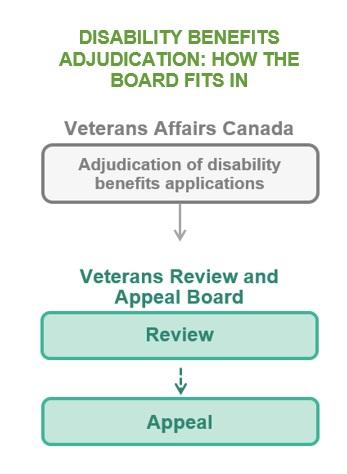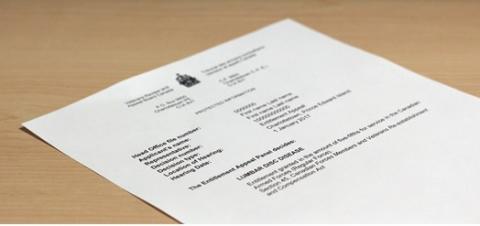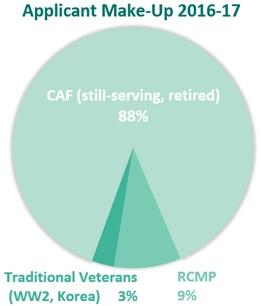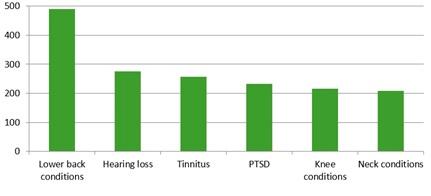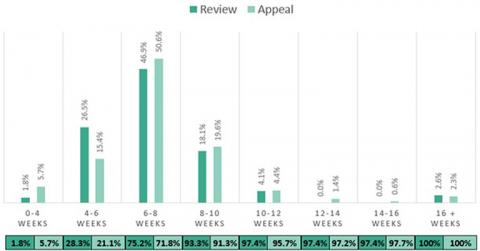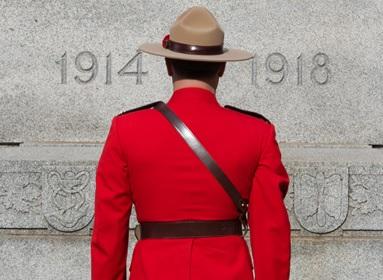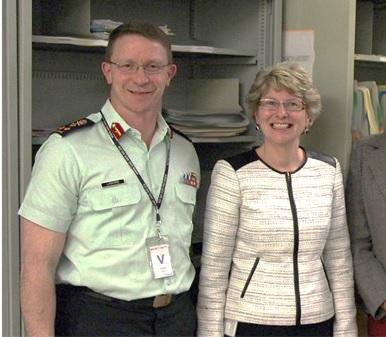
ISSN 2368-027X
Table of Contents
Chair's Message
This Annual Report details the Veterans Review and Appeal Board’s work in 2016-17 to deliver a national appeal program for Veterans’ disability benefits decisions made by Veterans Affairs Canada.
As usual, the most important accomplishment of our year was to conduct respectful hearings and make fair decisions for Veterans, Canadian Armed Forces (CAF) and RCMP members, and their families.
Last year, the Board heard 2,219 Reviews and 937 Appeals for applicants across the country. As a result, more than one-third of them received increased benefits for service-related disabilities from the Board.
The value of the Board, as an independent tribunal, is its ability to hear from the Veteran at the hearing and to consider their information with fresh eyes. Board Members most often rule favourably based on the Veteran’s testimony and new medical or documentary evidence obtained with the representative’s help.
Along with my leadership duties as Chairperson, I am also a Board Member and sit on panels with other Members to hear cases. Having heard hundreds of cases, I understand that it can be difficult for Veterans to revisit past events in service at their hearing. Others find the experience cathartic, and appreciate the opportunity to appear and tell us about their circumstances. Regardless, when Veterans come to the Board, we make efforts to put them at ease and make sure they have the chance to be heard.
In my outreach with senior military and RCMP leaders, I continue to emphasize just how critical it is for serving members to document events in service and to seek treatment for their injuries. Later on, this information will be necessary to demonstrate the connection between their disability and their service.
Over the last number of years, cases have become more and more complex—often involving medical conditions and issues that can be difficult to link to service. This complexity reinforces the Board’s commitment to carefully and fairly consider all the aspects of every case.
Looking back on the past year, I am very pleased with the work our Board Members and staff have accomplished on behalf of Veterans and their families. I invite you to read our Annual Report to learn more about the appeal program and our ongoing efforts to improve it.
Thomas Jarmyn, CD
Acting Chair
Veterans Review and Appeal Board
1. Who We Are and What We Do
WHAT WE DO FOR ILL AND INJURED VETERANS
The Board ensures that Canada’s Veterans receive the disability benefits to which they are entitled under the law. To do this, the Board offers two levels of redress for disability benefits decisions: a Review hearing; and, if the Veteran remains dissatisfied, a subsequent Appeal hearing.
The Board also hears Critical Injury Benefit applications and provides the final level of appeal for War Veterans Allowance decisions.
In 2016-17, the Board had an operating budget of $9.5 million to deliver a national appeal program with hearings across the country.
AN INDEPENDENT APPEAL PROCESS
The Board operates at arm’s length from the Department to provide a fair and independent appeal process. This means that the Board is an entirely separate organization. As independent decision-makers, Board Members are not bound by previous decisions and will change them to benefit Veterans based on credible evidence.
VISION, MISSION, VALUES
The Board’s Vision, Mission, and Values express our commitment to serving Veterans and their families. These statements inform our work and guide all employees.
- Vision
- The Board is recognized as the independent and fair appeal tribunal that ensures Veterans obtain the benefits they are entitled to for service-related disabilities.
- Mission
- To provide Veterans, Canadian Armed Forces and RCMP members, and their families with timely, respectful hearings and fair, plain-language decisions.
- Values
- Independence: We provide Veterans with hearings and decisions that are free from outside influences.
- Impartiality: We treat Veterans in a fair and unbiased manner.
- Respect: We treat Veterans, and one another, with courtesy and respect.
- Excellence: We strive to serve Veterans better through continuous improvement and innovation.
- Integrity: We enhance public confidence and trust in the appeal process by being professional and ethical.
- Accountability: We are open and transparent, so that Veterans and Canadians can hold us accountable for our actions and decisions.
THE BOARD: AN ADMINISTRATIVE TRIBUNAL
Administrative tribunals like the Board are highly specialized in the kind of cases they hear. They give dissatisfied people an avenue of appeal that is less formal, less costly, and less time-consuming than the courts.
The Board’s work is governed by the:
It is important to note that section 3 of the VRAB Act requires the Board to liberally construe and interpret the legislation to fulfill the recognized obligation of the people and Government of Canada to those who have served their country so well, as well as their dependents.
Applications for Review and Appeal can be made to the Board under the:
- Pension Act;
- Canadian Forces Members and Veterans Re-establishment and Compensation Act - Part 3 (New Veterans Charter);
- War Veterans Allowance Act;
- Royal Canadian Mounted Police Pension Continuation Act; and
- Royal Canadian Mounted Police Superannuation Act.
Text Version
Our Organization
The graphic describes VRAB's organizational structure.
The top line of the organizational structure graphic contains the Chairperson position. Solid lines are drawn from the Chairperson position to the Deputy Chairperson and members' positions and to the Director General position.
A dotted line leads from the Chairperson position to Legal Services unit.
Solid lines are drawn from the Director General position to Operations and Professional Development, Legal Services, Strategic and Corporate Services, Communications and Systems Units.
OUR ORGANIZATION
The Board is a micro-organization with a small, dedicated staff. The Chairperson, appointed by the Governor in Council, is the Board’s Chief Executive Officer and reports to Parliament through the Minister of Veterans Affairs.
The Board has up to 25 full-time Members (including the Chair and Deputy Chair). They hear cases brought forward for redress at the Board, and decide whether the evidence meets the requirements of the legislation to award new or increased levels of disability benefits.
The Director General provides strategic leadership for the effective planning and management of Board operations and corporate management functions. The Board employs approximately 75 public servants to support the delivery of its program.
The Board was pleased to have two of its employees selected to go to France for the 100th anniversary of
the Battle of Vimy Ridge. One of them worked at Canada Office in Arras, dealing with inquiries from
Veterans and the public regarding commemoration activities.
2. The Board's Program
REVIEW HEARINGS
Review hearings are conducted by panels of two Board Members in locations across the country. Here, Veterans have the opportunity to give oral testimony, present evidence and arguments, and bring witnesses in support of their case.
This is their only opportunity in the disability benefits adjudication process to appear before decision-makers and tell their story in their own words. Veterans have access to free legal counsel through the Bureau of Pensions Advocates (BPA), and are reimbursed for their travel costs to attend their hearings.
The Board’s process is non-adversarial, which means no one is arguing against the Veteran or defending the VAC decision under review.
Hearings are open to the public, except in special circumstances where the Veteran requests and is granted a closed hearing (subsection 36(2), VRAB Act). We encourage members of the public to attend hearings, as this contributes to a greater understanding of the Board’s decision-making. Anyone interested in observing hearings should consult our hearing calendar.
Text Version
Review Hearing Locations
The following is a list of Review Hearing locations:
- St. John's
- Sydney
- Halifax
- Charlottetown
- Moncton
- Fredericton
- Quebec
- Montreal
- Kingston
- Ottawa
- Peterborough
- Toronto
- Hamilton
- London
- North Bay
- Winnipeg
- Regina
- Calgary
- Edmonton
- Penticton
- Vancouver
- Victoria
- Courtney/Comox
APPEAL HEARINGS
If a Veteran is dissatisfied with their Review decision, they can request an Appeal hearing which is the second and final level of redress.
Appeal hearings are conducted primarily in Charlottetown, Prince Edward Island by panels of three Board Members who did not hear the same case at Review. While the legislation does not permit oral testimony at this level, the Appeal hearing provides a further opportunity for a Veteran, through their representative, to submit new information and make arguments in support of their case. Appeal decisions are final and binding.
WHAT IF A VETERAN IS DISSATISFIED WITH AN APPEAL DECISION?
Veterans who are dissatisfied with their final-and-binding Appeal decision can apply to the Board for a Reconsideration (i.e. a reopening of the case) if new, credible, and relevant evidence comes to light at a later date, or if an error in fact or law is found in the Appeal decision.
If a Veteran has exhausted all redress options at the Board and is still dissatisfied, they have the right to apply to the Federal Court of Canada for a judicial review of the decision. In a judicial review, the Court’s role is to decide whether the Board made a reasonable decision based on the evidence before it and whether it properly performed its function in making the decision, not to rule on the merits of the case (i.e. whether the Veteran should receive a favourable decision from the Board).
Written Decisions with Reasons
After a hearing, Board Members discuss the information and arguments of the case to make a decision. They conduct a thoughtful analysis of all available information (i.e. oral testimony, medical reports, opinion evidence from experts, written statements, etc.) and discuss the merits of the case, bearing in mind the requirement to resolve any doubt in the weighing of evidence in favour of the Veteran. At Review, if the two panel members disagree, the decision most favourable to the Veteran stands; at Appeal, the decision of the majority of the three panel members stands.
The Board is required by law to prepare written reasons to inform Veterans of how and why the decision has been made. These are prepared at the Board’s office in Charlottetown and usually mailed within six weeks of the hearing. This time is needed to ensure decisions are well-reasoned and clearly written.
3. Caseload
INCOMING CASES
A good indicator of how many applications the Board is likely to receive in a given year, is the volume of VAC’s disability benefits decisions from the previous year. As the table to the right shows, in the last five years, our Review decisions have represented between 6.0% and 9.1% of VAC decisions with appeal rights to the Board from the previous year.
Even though our caseload is primarily correlated with VAC decision volumes, it can fluctuate from year to year due to other factors. One of these is that there is no time limit to bring forward an appeal, i.e. Veterans can request an independent review of their VAC decision at any time.
Other factors could include changes to VAC’s adjudication model, their favourability rates, and their timeliness in processing applications and issuing decisions. Our caseload can also be impacted by the availability of BPA representatives to prepare and bring cases forward to the Board.
Regarding the individuals who made applications to the Board in 2016-17, there was a small change in the breakdown of service, with a larger percentage of applications from still-serving and retired CAF members, and a smaller percentage of applications from RCMP applicants.
| Fiscal Year |
VAC decisions* |
VRAB Review decisions |
As a % of VAC's previous year decisions |
|---|---|---|---|
| 2016-17 | 36,502 | 2,219 | 6.0% |
| 2015-16 | 37,004 | 2,507 | 8.5% |
| 2014-15 | 29,480 | 2,729 | 8.3% |
| 2013-14 | 32,963 | 3,213 | 9.1% |
| 2012-13 | 35,139 | 3,236 | 9.1% |
*VAC decisions with appeal rights to VRAB, i.e. first applications, medical reassessments, and departmental reviews.
WORKLOAD STATISTICS
The tables below provide information about the nature, volume, and outcome of cases at the Board, as well as information on the number and outcome of Federal Court judicial review decisions.
| Fiscal Year |
Review | Appeal | Reconsideration | War Veterans Allowance |
Total Decisions |
|---|---|---|---|---|---|
| 2016-17 | 2,219 | 937 | 119 | 4 | 3,279 |
| 2015-16 | 2,507 | 793 | 87 | 2 | 3,389 |
| 2014-15 | 2,729 | 1,039 | 105 | 4 | 3,877 |
| 2013-14 | 3,213 | 1,159 | 142 | 11 | 4,525 |
| 2012-13 | 3,236 | 928 | 121 | 9 | 4,294 |
| Fiscal Year | Review % Favourable | Appeal % Favourable |
|---|---|---|
| 2016-17 | 42 | 26 |
| 2015-16 | 52 | 39 |
| 2014-15 | 49 | 43 |
| 2013-14 | 47 | 43 |
| 2012-13 | 51 | 34 |
** Note: The Board’s systems track applications received. An application may include rulings on more than one medical condition or type of service. When a Veteran receives an increased level of entitlement or assessment for one aspect of their application, the decision is counted as favourable.
| Fiscal Year | Number of FC decisions |
Number that upheld VRAB decision |
Number that overturned VRAB decision |
|---|---|---|---|
| 2016-17 | 9 | 7 | 2 |
| 2015-16 | 10 | 8 | 2 |
| 2014-15 | 6 | 4 | 2 |
| 2013-14 | 11 | 8 | 3 |
| 2012-13 | 10 | 6 | 4 |
Top 6 medical conditions in 2016-17
NATURE OF APPLICATIONS AND DECISIONS
In general, the Board receives two kinds of applications:
- those for entitlement to benefits based on the relationship between the disability and service; and
- those related to the level of assessment based on the extent or severity of the disability.
In 2016-17, entitlement cases made up 72% of our work, and assessment cases 28%.
Members often rule favourably due to a combination of factors. Last year, testimony and/or new medical or other documentary evidence were the basis for 81% of favourable Review decisions. In the remaining cases, Members ruled favourably based on the available evidence, changes in policy/law, or errors in the previous decision.
This demonstrates the ongoing need for an independent appeal process so that Veterans receive timely access to benefits for their service-related disabilities. The Board shares its reasons for awarding with VAC to support their efforts to identify trends and opportunities for improvements.
COMPLEXITY OF CASES
In the last five years, VAC’s favourability rate has increased significantly, from 70% on first application in 2012-13, to 83% in 2016-17. In other words, more Veterans have been receiving positive outcomes earlier in the process (i.e. at VAC), and no longer need to seek redress at the Board.
This means that the cases that are appealed to the Board tend to be less straightforward. They often involve complex medical conditions and other issues that make it challenging for the Veteran to establish the required relationship between the disability and service in entitlement applications.
As a result, the Board’s favourability rate for entitlement applications (the majority of our work) has dropped in the last five years, which has contributed significantly to the drop in our overall favourability rate.
This increased complexity has had an impact on the Board’s operations and decisions. Perhaps most significant is the time spent by Veterans and their representatives obtaining supporting evidence to prepare their case. The Board does not limit this valuable time; instead, we wait for the representative to tell us they are ready to proceed before scheduling the hearing.
For its part, the Board requires additional effort and time to provide quality documentation for Veterans’ hearings. We ensure that the Statement of Case (the evidence package used by all the hearing parties) is well-organized, accurate, and complete. As a first step, we obtain relevant records—Veterans’ medical and service records—either from VAC or, increasingly from National Defence (if not previously requested by VAC). These records, which come from other organizations, sometimes contain errors. For that reason, we review all incoming documentation to ensure it pertains to the individual in question, that scanned documents are legible, and that there are no duplications.
After the hearings, Board staff support Members by reviewing decisions to ensure that information is presented logically, that evidence and arguments have been addressed, and that reasons are clearly and plainly expressed.
Going forward, we are continuing to explore ways to better prepare and equip our Members to deal with an increasing number of cases involving complex matters.
EVOLVING DEMAND FOR HEARINGS
The geographical distribution of Veterans applying for a Review hearing can vary annually. This fluctuating demand has an impact on scheduling and travel for hearings.
Every year, the demand for hearings declines in some locations and increases in others. In 2016-17, the Board worked closely with representative organizations to determine where and how often it should convene hearings based on the demand from Veterans and other applicants.
The Board offers videoconferencing across the country, especially for low-volume locations, in order to get cases heard more quickly. We continue to encourage representatives to speak with Veterans about the possibility of videoconferencing.
In 2016-17, we also continued our priority to hear cases from Veterans of the Second World War and the Korean War in recognition of their service and age.
Free Representation
Veterans who are dissatisfied with a VAC decision have access to free advice and representation from external organizations with expertise in Veterans’ disability benefits.
The Bureau of Pensions Advocates (a free legal service provided by the Government of Canada) represents the vast majority of Veterans at Board hearings.
Service Officers from Veterans’ organizations represent some Veterans, while a small number of Veterans choose to represent themselves or hire a private representative at their own expense.
Timeliness
The Board strives to provide Veterans with timely service. We have demonstrated our commitment to timeliness by establishing service goals for the time within our control, and meeting them for the vast majority of cases.
16 Weeks
When a Veteran decides to appeal their departmental decision to the Board, they contact the Bureau of Pensions Advocates or another representative organization. The representative works with the Veteran to prepare the case, taking valuable time to obtain additional information and evidence.
Once the representative and Veteran advise the Board that they are ready to proceed, our goal is to schedule a hearing, conduct the hearing, and issue the decision within 16 weeks. Last year, we achieved this in 97% of Review and 98% of Appeal cases. Also noteworthy is that the vast majority of cases (93% of Reviews and 91% of Appeals) were actually heard and decided within a much shorter time—just 10 weeks—as the following table shows:
Timely Decisions
The 16-week service commitment includes the time it takes for the Board to issue a decision. The Board’s commitment is to issue 80% of decisions within six weeks of the hearing date. Last year, the Board exceeded its goal, issuing 87% of Review and 88% of Appeal decisions within six weeks of the hearing.
4. Year in Review
OPERATIONS
Making Progress on Paperless Hearings
Last year, the Board made good progress in developing a paperless hearing process to increase efficiency and reduce time spent mailing documents between our administration office in Charlottetown and hearing locations across Canada. To ensure a smooth transition, we have:
- performed a privacy impact analysis to ensure the security of Veterans’ information;
- tested and implemented new equipment;
- piloted paperless hearings in several locations;
- developed and implemented the use of digital documents;
- worked with stakeholders to develop methods of sharing evidence electronically;
- developed electronic schedules which will be shared automatically and securely with staff, Members and representatives;
- researched the feasibility of using electronic signatures; and
- trained staff and Members on new processes.
For the most part, these changes will be invisible to Veterans, but will result in a faster hearing process. Our goal is to fully implement paperless hearings in 2017-18.
Spotlight on Privacy
In 2016-17, our Access to Information and Privacy (ATIP) Unit continued to provide leadership on privacy matters at the Board. This included:
- Putting a spotlight on the appropriate use and protection of Veterans’ personal information during our third annual Privacy Month in May 2016.
- Reminding employees how to safely dispose of protected information.
- Completing Preliminary Privacy Impact Assessments for four new projects to ensure they met basic privacy requirements.
For the second year in a row, no material privacy breaches occurred at the Board.
Did you know?
As of May 5, 2016, Canadians are no longer required to pay processing fees for formal requests under the Access to Information Act. The only remaining fee is the $5 application fee, which government institutions can choose to waive. In 2016-17, the Board waived this fee in consideration of the core principle of the Act—that government information should be available to the public.
Strategic Plan 2016-2021
In May 2016, the Board released an updated strategic plan to guide its work for Veterans and their families over the next five years. The plan highlights how we will modernize our program by improving our systems and streamlining our processes to serve Veterans better. It describes how our work is evolving and what we are doing to support our Members and staff through change.
Here is a snapshot of our progress in 2016-17 towards our three strategic priorities.
Excellence in Service Delivery
- Piloted paperless hearings in several locations
- Automated more of the Board’s scheduling practices
- Worked towards making Statements of Case available in My VAC Account
- Moved the Board’s corporate and program information into the GCDOCS content management system
- Continued to ask applicants for feedback on their Review hearing through an exit survey
- Established a plain language strategy for the Board
- Updated the legal training manual for Members
- Continued to offer videoconference hearings and flexible hearing weeks for Veterans in low volume locations
High-Performing Organization
- Updated the Board’s Integrated Business Plan to align human resources with priorities
- Continued to require performance agreements and assessments for all staff
- Provided continuous learning opportunities for staff
- Supported employees through workshops and activities focused on mental health
Transparency and Accountability
- Published materials, including the Review hearing calendar, on our website
- Continued to post all Board decisions on the Canadian Legal Information Institute’s website
- Worked with the Department of Justice to draft rules of procedure
- Communicated regularly with stakeholders
- Developed a new plain language brochure and information videos for applicants
Rules of Procedure
In 2018, the Board will be introducing rules of procedure to help Veterans and their representatives prepare for their hearings and obtain the best possible outcome. These rules will explain what the Board needs in terms of evidence and information, so that Veterans and their representatives can bring forward the best, most complete cases. The rules will also help us to increase efficiency, transparency and consistency in processing Veterans’ applications.
The Board is working with the Department of Justice to draft these rules, which are statutory instruments. The proposed rules will be published in the Canada Gazette for public comment before coming into effect.
PUBLISHING DECISIONS
As a quasi-judicial tribunal, the Board is bound by the open court principle, which assumes that public confidence in—and understanding of—decision-making requires openness and transparency.
Publishing decisions is important because it allows Veterans to see how the Board applies the law in cases similar to their own, and shows Canadians that the Board is fulfilling its obligations. In short, publishing decisions increases transparency and confidence in the appeal process.
In 2015, the Board began having its decisions published on the Canadian Legal Information Institute (CanLII) website, a well-known legal resource that organizes decisions by year and is searchable by key word. The Board continued this work in 2016-17, sending all decisions to CanLII and promoting this invaluable resource to stakeholders. By March 31, 2017, approximately 6,000 decisions were available there.
Though not required to, the Board depersonalizes decisions before publishing in keeping with best practices from the Office of the Privacy Commissioner of Canada.
DECISION-MAKING
The Board is required to provide written reasons for its decisions so that Veterans know how and why the decision has been made.
The following decisions, issued in 2016-17, illustrate the value of new evidence and testimony in cases that come before the Board.
Review of evidence and value of oral testimony
This case was about a Veteran seeking an increase in the assessment for Exceptional Incapacity Allowance, which had been awarded due to his many service-related disabilities (including PTSD, shrapnel wounds, ruptured eardrums, and tinnitus). At his hearing, he spoke about the many difficulties he encounters in his daily life due to his various conditions and hospitalization for a medically-induced coma. His representative argued that VAC’s decision had not explained why the assessment was lower than what had been recommended in a nurse’s report. In its decision, the Board ruled to increase the assessment based on the nurse’s report and the Veteran’s credible testimony.
Service-related sports injury and subsequent cumulative trauma
This case was about a Veteran who had been denied entitlement to a disability award for Cervical Disk Disease (CDD). His VAC decision cited a lack of evidence of neck injuries during service. At his hearing, the Veteran testified that he believed his condition was caused by injuries from playing sports in service and aggravated by many hours of wearing flight helmets and night vision goggles. The Board awarded full entitlement in its decision, relying on the Veteran’s testimony, records of repeated neck and back complaints which began five years after his enrolment, and his diagnosed CDD at a young age.
Lack of evidence and a credible medical opinion
The issue in this case was whether the Veteran’s dilated nonischemic cardiomyopathy arose out of, or was directly connected to, his military service. In its decision, the Board acknowledged that while the Veteran had believed his heart condition was related to exposure to a “carcinogen” during service, this belief was not an appropriate substitute for a credible medical opinion. The decision explains that there were no reports or any information about the type, duration, or an amount of exposure to any specific chemical or substances, or of any medical treatment for such an exposure. Also, there was no medical opinion that explained the relationship between the Veteran’s heart condition and his military service.
BOARD MEMBERS
Member Selection Process
Board Members are appointed by the Governor in Council (GIC) on recommendation from the Minister of Veterans Affairs.
In 2016-17, the Board helped to implement a new selection process for GIC appointments. This was the result of a February 2016 announcement by the Prime Minister to develop a new approach for GIC appointments across government.
In the first half of the year, the Board worked with the Privy Council Office to launch the new Member selection process. In November 2016, interested Canadians were invited to apply on the new process through the GIC website. In the last four months of the fiscal year, applications were screened, and exams and interviews carried out. Additionally, an anticipatory Member selection process was launched in February to help the Board fulfill its membership needs into the future.
Member Training and Professional Development
Like all courts and tribunals, the Board strives for consistency in decision-making by supporting its decision-makers through ongoing training, quality review of decisions, and performance feedback.
Last year, the Training and Professional Development Unit enhanced the training program in preparation for the appointment of a group of Members through the new appointment process.
At the same time, the Board’s Legal Services Unit decided to modernize the legal components of the Members’ training. It began work and made significant progress on a new, comprehensive legal training e-manual. As the Board moves to a paperless process, this new electronic training manual will serve as a guide to new Members regarding the essential elements and skills needed in their role as adjudicators, and support all Members on an ongoing basis.
Member Training Topics in 2016-17
Continuous training is extremely important. The following topics were covered last year.
From the Council of Canadian Administrative Tribunals:
- Access to Justice: Unequal Access to Evidence and Other Procedural Barriers
- New Ethics for Tribunals
- Administrative Law Update
- Discoveries in Understanding Impartiality in Decision Making
From subject experts:
- Plain Language Writing
- Time, Priority and Workflow Management
From Board staff:
- Reconsiderations
- Burden of Proof
- Benefit of Doubt
- Use of Statistics
COMMUNICATIONS AND OUTREACH
The Board continued to make timely, accurate, and clear communications about its program a priority in 2016-17. Our goals were to raise awareness of appeal rights among serving personnel as well as to help applicants better understand the appeal process itself.
Outreach with Serving Personnel
The Board continued to engage with senior military leaders about the appeal program. In March, we were very pleased to host Lieutenant-General C.A. Lamarre, the new Chief of Military Personnel, for a briefing and tour of our operations in Charlottetown. We appreciated the time he spent with us and his engagement in learning about the appeal process. It remains the Board’s priority to raise awareness of appeal rights among serving personnel, and to underline how important it is for them to document events in service and to seek treatment for injuries.
Outreach with Veterans
The Board also worked with Veterans’ organizations to broaden its outreach in 2016-17. We participated in the Dominion Conventions for the Royal Canadian Legion and the Army, Navy and Air Force Veterans in Canada (ANAVETS), and supported them through training for their service and advocacy officers. The Board also attended VAC’s Stakeholder Summit in October, to stay engaged with Veterans and informed about priorities in policy and program development.
Outreach with Parliamentarians
Our Chairperson had the opportunity to appear at the House of Commons Standing Committee on Veterans Affairs in May, where he talked about the appeal process and answered questions. The Board provided information briefings and opportunities to observe Review hearings for Sherry Romanado, Parliamentary Secretary to the Minister of Veterans Affairs and Associate Minister of National Defence, as well as Member of Parliament John Brassard, Veterans Affairs Critic for the Conservative Party of Canada.
The Chief of Military Personnel with the Board's Director of Strategic and Corporate Services.
Outreach Tools
In 2016-17, the Board developed a series of short videos to explain how the appeal process works in a friendly and accessible format. The main video shows what a Review hearing looks like, so that Veterans know what to expect before their own hearing. Other videos in the series provide useful information about evidence requirements and decision making. These videos will be posted on our website in 2017 and used in our social media activities to reach the most Veterans.
We also updated our brochure for applicants. The new brochure, called “A Guide to Review and Appeal Hearings,” is a more modern, friendly, and useful brochure for Veterans, CAF and RCMP members, and their families.
It features:
- A new design and colour scheme
- A larger size for better presentation of information
- Additional helpful content about our hearings in plain language
The new brochure will be sent to all applicants as well as to VAC offices, stakeholders, and the CAF for distribution to all medically releasing personnel. It is also available on our website.
Plain Language Priority
We continued to make plain language writing a priority, so that our decisions and communications are clear and easy to understand. To support this commitment, the Board established a plain language strategy and provided Members and staff with targeted training from experts in the field.
Veterans at the Board
The Board is engaged in VAC’s Veterans Hiring Unit initiative which seeks to increase the number of Veterans employed in the Portfolio, and to establish the federal public service as a Veteran-hiring leader in Canada. We work with VAC to ensure that staffing processes are open and responsive to CAF members and Veterans.
The Board is fortunate to count a number of former or still-serving members of the Canadian Armed Forces among its public service employees and Members.
Acting Chair Thomas Jarmyn laying a wreath at the Charlottetown Cenotaph on Remembrance Day.
FEEDBACK
In 2013, the Board established an exit survey to gather feedback on the Review hearing experience. We did this because we wanted to know how Veterans felt about their hearings, whether we were fulfilling our commitment to provide a respectful hearing experience, and whether there was anything we could do to improve the hearing for Veterans.
Over the last four years, approximately half of all Veterans who had a Review hearing completed our exit survey, providing us with a great deal of useful information. In 2016-17, as in the three preceding years, the vast majority of Veterans indicated that they had a good experience at their hearing.
95%
said that the Board
treated them with
respect.
Of particular importance: 95% told us that Board Members treated them with respect; 92% said Board Members listened to what they had to say; and 89% said their hearing was conducted in a fair manner.
In last year’s survey, we included an additional, optional question which asked respondents to identify which medical condition(s) their hearing dealt with. The responses of those who had psychiatric or mental health conditions were less favourable (by 3 to 11%) across all questions. These lower satisfaction rates confirm the need for the Board to be especially sensitive to the needs of Veterans with mental health conditions at hearings. Currently, the Board does a number of things in this regard (e.g. working with representatives to accommodate special needs, allocating more time for the hearing), but will consider other actions it could take to make the hearing experience more comfortable for those dealing with psychiatric or mental health conditions.
Through a final, open-ended question, Veterans also provided us with many positive comments as well as instructive feedback about how we could do better. The Board uses this feedback in Member training and to inform communications products with the goal of improving the hearing experience for Veterans.
92%
said Board Members
listened to what
they had to say.
89%
said their hearing
was conducted in a
fair manner.
5. Looking Ahead
Like all government departments, the Board has established its first Departmental Plan (replacing the Report on Plans and Priorities). It is a new, simplified report that provides Canadians with information about our work and goals for the upcoming year.
In 2017-18, our plan is focused on these new and ongoing initiatives:
- Further integrating technology into our operations to reduce reliance on paper and improve processing times;
- Enhancing training and professional development for Board Members to foster consistency in decision making;
- Establishing rules of practice and procedure to increase transparency and provide helpful information to Veterans and their representatives; and
- Improving communications by focusing on plain language and outreach with the CAF, the RCMP, and Veterans.
Going forward, the Board will also be establishing a new framework that will refine how we achieve, track and report on our results. For this results framework, we will:
- Identify results that flow from our core responsibility and are important to Veterans;
- Set meaningful performance targets and ways to measure progress; and
- Communicate to Canadians what we have achieved on their behalf and the resources used to do so.
By focusing on results, our ultimate goal is to ensure we fulfill our important mandate for Veterans and their families.
Contact Us
If you have any questions about the Board's work or would like more information about our program, please contact us:
- Email:
- Info@vrab-tacra.gc.ca
- Telephone:
Toll Free in Canada and the United States - 1-800-450-8006 (English)
- 1-877-368-0859 (French)
- Telephone:
From all other locations, call collect - 0-902-566-8751 (English)
- 0-902-566-8835 (French)
- Mailing Address:
-
Veterans Review and Appeal Board
Post Office Box 9900
Charlottetown PE C1A 8V7 - Fax:
- 1-855-850-4644
- Website:
- www.vrab-tacra.gc.ca
- Twitter:
- @VRAB_Canada
- @TACRA_Canada


